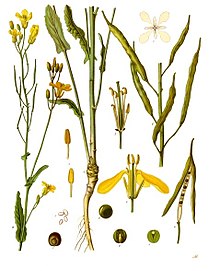
Back سلجم Arabic سلجم ARZ Brassica napus AST Raps Azerbaijani راپس AZB Рапс Bashkir Rapsos BAT-SMG Рапс Byelorussian Рапс BE-X-OLD Рапица Bulgarian
| Rapeseed | |
|---|---|

| |
| Scientific classification | |
| Kingdom: | Plantae |
| Clade: | Tracheophytes |
| Clade: | Angiosperms |
| Clade: | Eudicots |
| Clade: | Rosids |
| Order: | Brassicales |
| Family: | Brassicaceae |
| Genus: | Brassica |
| Species: | B. napus
|
| Binomial name | |
| Brassica napus | |
Rapeseed (Brassica napus subsp. napus), also known as rape and oilseed rape, is a bright-yellow flowering member of the family Brassicaceae (mustard or cabbage family), cultivated mainly for its oil-rich seed, which naturally contains appreciable amounts of mildly toxic erucic acid.[2] The term "canola" denotes a group of rapeseed cultivars that were bred to have very low levels of erucic acid and which are especially prized for use as human and animal food. Rapeseed is the third-largest source of vegetable oil and the second-largest source of protein meal in the world.[3][4]
- ^ GRIN 2010a.
- ^ Food Standards Australia New Zealand (June 2003) Erucic acid in food: A Toxicological Review and Risk Assessment Archived 23 November 2018 at the Wayback Machine Technical report series No. 21; Page 4 paragraph 1; ISBN 0-642-34526-0
- ^ USDA 2002, p. 26.
- ^ Heuzé et al. 2020.
Cite error: There are <ref group=note> tags on this page, but the references will not show without a {{reflist|group=note}} template (see the help page).